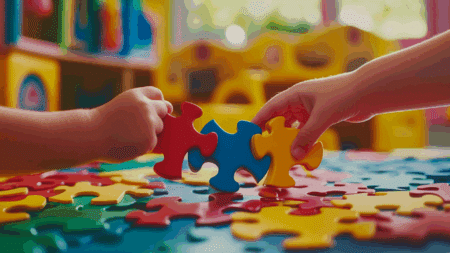Students often feel lost when connecting what they learn in science class with real-world applications.
The gap between textbook formulas and practical uses can make STEM subjects seem abstract and hard to grasp.
Good news! Anyone can better understand and apply STEM knowledge by looking at concrete examples that link classroom concepts to everyday life. This approach transforms dry theories into useful tools that solve actual problems.
This article will show you several examples of how STEM examples and their principles work in our daily lives. We’ll examine how physics explains common activities, how chemistry helps create products we use, and how math solves practical issues.
Through these examples, you’ll see how STEM education creates valuable skills for many career paths and everyday situations.
Everything You Need to Know About STEM
STEM stands for Science, Technology, Engineering, and Mathematics. It’s a term that groups these four related fields because they often overlap and work together in the real world.
Science is about studying the natural world through observation and experiments. When you test how plants grow in different soils or learn why objects fall to the ground, you’re doing science.
Technology refers to the tools, devices, and systems we create to solve problems. Your smartphone, computers, and even simple tools like pencils are all technology.
Engineering involves designing and building things. Engineers use math and science to create everything from bridges and buildings to robots and medical devices.
Mathematics is the study of numbers, shapes, patterns, and how they relate to each other. Math helps us count, measure, and explain the world around us.
Stem education focuses on teaching these subjects in ways that show how they connect and apply to real-life situations. Instead of learning each subject separately, STEM often combines them through hands-on projects and problem-solving activities.
Benefits of STEM Education for Kids

Stem education goes far beyond just teaching science or math facts. It creates a foundation for how children think, solve problems, and understand the world around them.
The following are some benefits of STEM education for Kids:
- Builds problem-solving skills: Children learn to break down complex issues into manageable steps and find creative solutions.
- Encourages critical thinking: STEM activities push kids to ask “why” and “how” questions, testing their ideas and forming logical conclusions.
- Fosters creativity: Contrary to popular belief, STEM fields need creative thinking to design new solutions and approaches to problems.
- Develops teamwork abilities: Many STEM projects involve collaboration, teaching kids to communicate ideas and work together effectively.
- Creates tech literacy: In our digital world, understanding technology basics gives kids confidence and essential life skills.
- Connects abstract concepts to real life: STEM shows how classroom learning applies to everyday situations, making education more meaningful.
- Prepares for future careers: Many growing job fields need STEM skills, giving kids more options as they grow.
- Builds confidence: Completing STEM challenges helps children trust their abilities and tackle new challenges.
- Makes learning fun: Hands-on STEM projects engage kids through play and exploration, creating positive associations with learning.
Stem Examples: Real-World Applications

Stem isn’t just about classroom learning or complex theories. It’s all around us, working behind the scenes in almost everything we use and do each day.
From the moment you wake up until you go to sleep, STEM makes your daily life easier, safer, and more connected.
1. Smartphone Technology
Your smartphone combines all STEM fields. Physics principles guide touchscreen function, computer science powers apps and operating systems, engineering creates the physical components, and math algorithms process everything from calls to photos.
2. Weather Forecasting
Meteorologists use advanced math models, satellite technology, and atmospheric science to predict weather patterns. This helps everyone from farmers planning crops to cities preparing for storms.
3. Medical Imaging
MRI and CT scans use physics principles to create detailed images of the human body. These tools help doctors diagnose and treat medical conditions without invasive procedures.
4. Traffic Light Systems
Traffic management uses sensors, computer algorithms, and timing mathematics to control the flow of vehicles. Engineers design these systems to reduce congestion and improve safety.
5. Food Production
Modern farming uses biology, chemistry, and technology to grow crops more efficiently. From soil testing to GPS-guided tractors, stem makes our food system more productive.
6. Water Purification
Clean drinking water comes from engineering processes that use chemical treatments and physical filtration. Mathematics helps calculate the right amounts of chemicals and flow rates.
7. Solar Energy
Solar panels convert sunlight to electricity using physics principles. Materials science, electrical engineering, and mathematical modeling all work together to make this renewable energy source possible.
8. Video Games
Game development combines computer programming, physics simulations, artistic design, and complex math. Even simple games require an understanding of angles, velocity, and probability.
9. GPS Navigation
The Global Positioning System uses satellite technology, physics, and mathematical triangulation to pinpoint your location. Software engineering then creates the maps and directions we use daily.
10. 3D Printing
This technology combines material science, computer modeling, and precise engineering to create objects layer by layer. It’s transforming fields from medicine to manufacturing.
11. Wireless Communication
Wi-Fi, Bluetooth, and cellular networks rely on radio wave physics, signal processing mathematics, and complex engineering to send data through the air. This invisible technology connects our modern world.
STEM Activities for Different Age Groups

The following is a table of STEM activities for kids, broken down by age group:
| Age Group | STEM Activity | How to play |
|---|---|---|
| 3–5 Years | Build a Marshmallow Tower | Use toothpicks and marshmallows to make shapes and towers. |
| Color Mixing with Water | Combine colored water in cups to find color blending. | |
| Sink or Float | Drop objects in water to see which items sink or float. | |
| 6–8 Years | Balloon Rocket | Tape a balloon to a straw on a string and watch it zoom. |
| Lego Zipline | Create a Lego figure and send it down a homemade zipline. | |
| Homemade Volcano | Mix baking soda and vinegar for an erupting volcano. | |
| 9–11 Years | Paper Circuit Card | Build a simple light-up greeting card using paper, copper tape, and LEDs. |
| Egg Drop Challenge | Design a container to protect an egg from a high fall. | |
| Solar Oven S’mores | Use a pizza box and foil to make a solar-powered oven for s’mores. | |
| 12–14 Years | Water Filtration Experiment | Build a basic filter with sand, gravel, and charcoal to clean dirty water. |
| Coding with Scratch | Create interactive stories or games using block-based coding in Scratch. | |
| Build a Model Bridge | Use popsicle sticks to engineer a strong mini bridge and test its weight. | |
| 15–17 Years | Arduino Light Project | Program an Arduino to control blinking LED lights. |
| Physics Roller Coaster Design | Design and test a marble roller coaster for speed and loops. | |
| Chemistry Elephant Toothpaste | Combine yeast and hydrogen peroxide for a foamy chemical reaction. |
Ways To Show Kids How STEM Examples in Everyday Life

Kids often wonder why they need to learn science or math. The truth is STEM is everywhere around us! By pointing out these everyday examples, you can help children see the value in what they’re learning at school and spark their interest in these important subjects.
1. Cooking Together
Cooking is chemistry and math in action. Measuring ingredients teaches fractions, mixing creates chemical reactions, and heating food transforms its properties. Next time you cook, let kids measure, mix, and observe how ingredients change when combined or heated.
2. Building Block Challenges
When children play with building blocks, they’re finding engineering concepts. Create fun challenges like “build the tallest tower that won’t fall” or “make a bridge that can hold this toy car.” This helps them learn about balance, stability, and design.
3. Nature Walks
A simple walk outside can become a science lesson. Count different types of plants, look for patterns in leaves, or observe insect behavior. Ask questions like “Why do you think this flower has bright colors?” to encourage scientific thinking.
4. Weather Watching
Track the weather together using simple tools like a rain gauge or thermometer. Keep a chart of daily temperatures or rainfall amounts. This introduces kids to data collection, observation skills, and pattern recognition.
5. Grocery Store Math
Shopping trips offer perfect math practice. Ask younger kids to count items or compare prices. Older children can calculate price per unit, estimate the total bill, or work out discounts during sales.
6. Home Gadget Exploration
Take apart old, broken devices (with proper safety) to see how they work inside. Clocks, toys, or simple electronics can show kids the engineering that makes everyday items function.
7. Kitchen Science Experiments
Simple experiments like making a volcano with baking soda and vinegar or creating slime teach chemistry concepts in fun ways. These hands-on activities show how science creates observable reactions.
8. Garden Planning
Growing plants teaches biology and environmental science. Kids can measure growth rates, learn about plant needs, and observe the life cycle from seed to plant.
9. Star Gazing
Looking at the night sky introduces astronomy. Use free apps to identify stars and planets, track moon phases, or spot satellites passing overhead.
The Bottom Line
Stem isn’t a distant concept found only in labs or tech companies. It lives in our kitchens, playgrounds, grocery stores, and even the night sky.
By showing kids these everyday connections, we help them see that science, technology, engineering, and math aren’t just school subjects; they’re tools for understanding and improving the world.
When children recognize STEM examples in their daily lives, learning becomes meaningful. They gain confidence in their ability to solve problems, think critically, and create solutions. These skills will serve them well no matter what path they choose.
So next time a child asks, “Why do I need to learn this?” point to the world around them. The answer is everywhere in cooking measurements, building blocks, growing plants, and countless other everyday moments where stem quietly shapes our lives.




